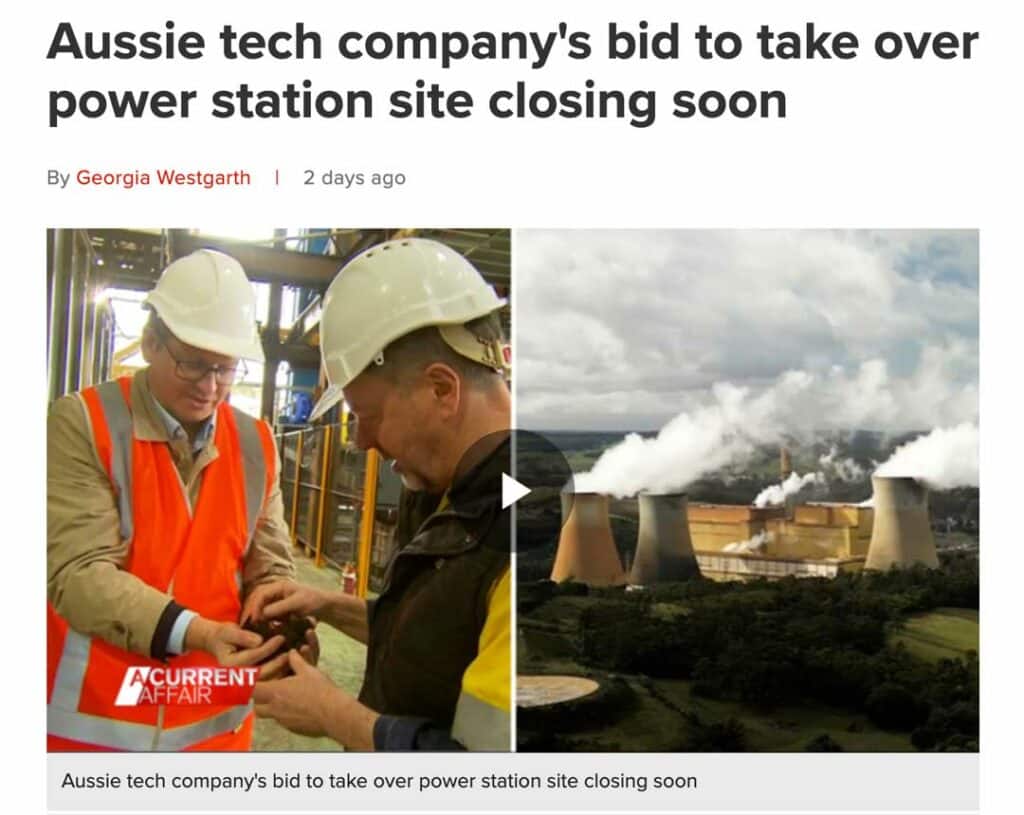Investor News
Clarification of recent media coverage

We have recently been highlighted in several external publications, including:
- Nationally broadcast TV news show, A Current Affair, as a potential net-zero emission technology solution for the future use of brown coal (lignite), in the context of the planned 2028 closure of the Yallourn power station and mine
- Invest Victoria’s (IV) International Investment Report 2021-22, as a case study for IV’s R&D funding program (page 25)
As a result, there are a number of statements that require correction or clarification.
Corrections & Clarifications
- We do not propose to take over the Yallourn Power Station to create green energy. However, we are interested in accessing the mine infrastructure and the lignite resource still available after the power station closes.
- We strongly support transitioning electricity production away from ageing power stations that are heavy CO2 emitters and diverting lignite use away from electricity production.
- The downstream products we aim to produce from our zero-emission COLDry process include:
- Clean hydrogen for transport and storage applications in both domestic and export markets, without the need for carbon capture and storage (CCS), and without the high cost attached to 'green' hydrogen
- Agricultural char for soil health and productivity, from a process that can deliver large volumes reliably and affordably
- Battery Active Carbon, which supports the tremendous amount of battery storage required to support the rollout of electric vehicles and mitigate the intermittency and variability of increased wind and solar penetration
- Industrial chemicals, including:
- Formic acid – a stockfeed preservative and a liquid organic hydrogen carrier
- Ammonia – the raw material for fertiliser production and a liquid hydrogen carrier
- Dimethyl Ether (DME) – a multiuse industrial chemical and fuel source
- In addition, we do not define the products we create as “green energy”. The term “green energy” refers to renewable energy sources, such as wind, solar and hydroelectric. So, for example, while our net-zero clean hydrogen is not “green hydrogen”, it does not rely upon CCS to achieve net-zero emission status and has been termed Viridian Hydrogen, reflecting its different feedstock and operating profile, being a mix of renewable and non-renewable sources, like biomass and lignite.
We also think it’s vital to clarify two key points regarding the proposed use of our technology, applied to lignite and biomass, which underpin the environmental credentials of our proposition.
1. Zero waste discharge
The global energy transition means a new era of demand for minerals such as copper, rare earths, lithium, nickel, chromium and graphite, with the number of mines and amount of extraction set to grow exponentially in some cases.
A future risk of this increased extractive activity includes the impact these new or expanded mines will have on our environment due to the scale and, in many cases, the poor environmental and labour standards in many countries.
ECT aims to produce ‘battery active carbon’, which will help to displace some of the need for new natural graphite mines. Graphite mines and synthetic graphite production generate a lot of waste, require significant water use, heavy use of chemicals and have a high CO2 footprint.
Mining of lignite, mixed with biomass to make ‘battery active carbon’, features zero-waste discharge, as all the mined resource is utilised and transformed into valuable products. This includes the water that can be captured from the drying, and the hydrocarbons transformed into syngas and then into hydrogen.
2. Preserving biomass as a waste
An understated yet significant future risk is the increasing use of biomass as a feedstock for energy projects.
There is a genuine danger that waste biomass will be relied on too heavily, changing what was once a waste feedstock, destined to join the carbon cycle through natural decay, to quickly becoming a primary feedstock grown, harvested and combusted, delivering incremental CO2 emissions beyond the intended natural cycle.
This is already happening in Europe, North America, India and China as an overreliance on biomass as a feedstock for new energy projects could see whole forests felled to service the steady state operations of many of these projects and a repeat of the environmental catastrophe seen with biodiesel and ethanol in the early 2000’s.
ECT has a vision for lignite playing the role of “chemical baseload”, effectively blending highly variable, naturally occurring waste biomass and keeping the demand for biomass in its process to the same supply levels of its status as a waste feedstock.
To better understand our process, we've created the short 30-second animation below.
If you have any questions or comments, please don't hesitate to contact us.